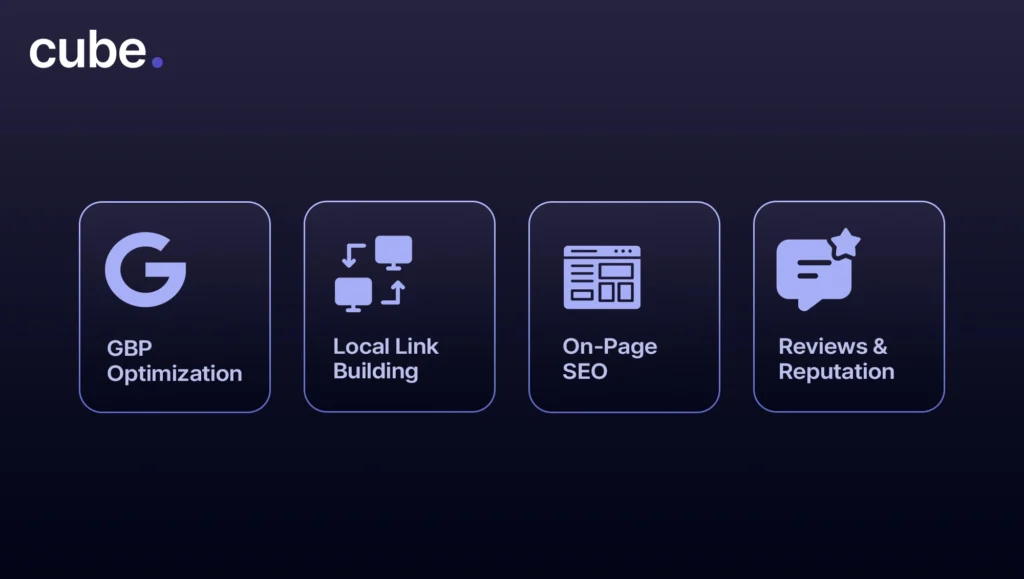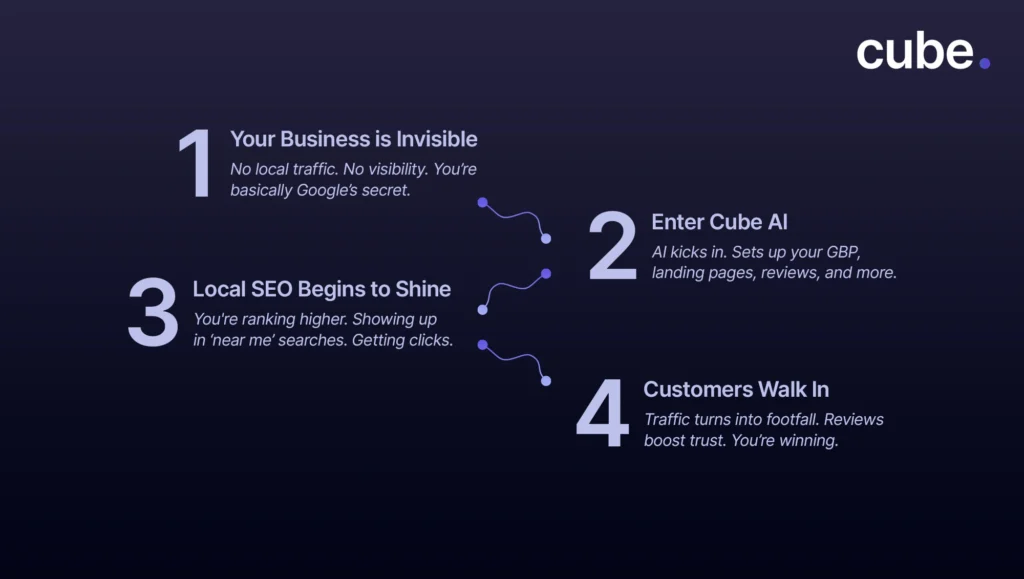Ever searched for “best pizza near me” and clicked the first result without a second thought? That’s the power of local SEO. For small businesses, appearing in those highly-targeted, location-based searches can mean the difference between being fully booked and barely staying afloat.
Unlike traditional SEO, which focuses on national or global rankings, local SEO is all about dominating your community. It’s about making sure your business shows up when your local community members are actively searching for exactly what you offer, right when they’re ready to make a purchase. With Google’s 2025 update, the importance of local SEO has never been clearer. Proximity, user reviews, and real-time intent are now given top priority.
If you’re a local business, now is the time to seize the opportunity. You don’t need a massive marketing budget. What you need is smart, strategic local optimization. In a world where convenience and proximity drive consumer loyalty, mastering local SEO can lead to real, measurable growth. Let’s explore how you can elevate your online presence and start attracting more local customers.
How Google Local Search Operates
Google’s local search may be considered cyber witchcraft, but surely someone’s made the rules of operation. Whenever someone searches for “near me” services, Google’s algorithm considers three critical things: relevance, proximity, and prominent online presence. That’s the formula it follows in determining what businesses appear within the coveted Google Map Pack — the first three search results you glimpse below the map. If you are not on that listing, you are missing out on paying customers.
And to achieve that, one of the largest weapons in your toolkit is the Google Business Profile (previously Google My Business). Your GBP listing isn’t simply a digital address. Consider it a live, dynamic profile that affects your local visibility. From operation hours and customer reviews to store photos and FAQs, it acts as a one-stop destination for your potential customers.
In 2025, Google’s local ranking factors are and will be even more complex. In addition to bare-bones information, the algorithm now takes into account the frequency with which you reply to reviews, the freshness of your content, and even how users engage with your listing. That’s why localised SEO success depends on optimizing your GBP for success.
The Core Elements of Local SEO Optimization

Being found locally isn’t happenstance; it’s strategy. At the center of local SEO optimization are a couple of non-negotiables: your Google Business Profile, the structure of your website, local backlinks, and what people say about you online. Get these right, and you’ve got a significant advantage over the competition.
Google Business Profile (GBP) Optimization
First things first: if you haven’t already claimed and verified your Google Business Profile, do it yesterday. This is the digital front door to your business. Put your real business name (no keyword spamming, please) in there, choose the most precise category, and write a concise, interesting business description that describes what you do best.
Don’t forget to add high-quality images and videos. They make your listing look sharp and boost engagements while fostering trust. Keep your hours, services, and contact info updated regularly. Use your GBP posts to promote offers or events, share content from other owned channels, and respond to reviews (yes, all of them). Engaging with customers through your profile shows Google — and your audience — that you’re alive and kicking.
On-Page SEO for Local Businesses
Your website is your home base, so let’s not leave it to gather dust. Utilize local keyword research to discover the words your community is looking for. Example: “emergency HVAC in Dallas” or “organic bakery in Portland.” Then optimize your title tags, headers, and meta descriptions with those words to wave a big, friendly hello to Google.
Operate from multiple locations? Create separate landing pages for each one, complete with embedded Google Maps and location-specific content. Publish blogs about local events, guides, or customer stories. SEO is not just about optimizing for search engine bots. It’s about sharing valuable information that your community members are actively searching for.
Local Link Building Strategies
Backlinks are links from one website to another. In simple terms, when another site links to your website, that’s a backlink. Google views these links as “votes of confidence” or endorsements of your website’s content. The more high-quality backlinks you have, the more Google trusts your site as an authority on your topic.
For local SEO, backlinks from local sources, such as nearby blogs, newspapers, community organizations, or local business directories, are particularly valuable. These types of links tell Google that your business is well-established in your local community and boost your visibility in local search results. Successful local SEO for small businesses relies on increasing both your digital visibility and your real-world credibility.
Reviews and Reputation Management
Reviews on the web are the new word of mouth, and they carry significant weight in local search results. Google loves to see a consistent flow of good reviews—it’s a signal of trust that can propel you up in results. But asking for reviews sounds creepy, right? We’ve discovered that a nice follow-up email or a QR code on receipts gets the job done. Or you can always use our review collections tool.
Bad reviews? Don’t worry. Answer professionally, fix the problem if you can, and move on. It demonstrates to potential customers that you care. Do not limit yourself to Google either. Third-party sites such as Yelp, Trustpilot, and TripAdvisor also build a balanced online reputation. Google also considers review variety and velocity (how frequently and on how many sites you’re receiving reviews), so do not ignore these. If replying to every single one of your reviews feels overwhelming, Cube AI can automate it for you. Our AI tool generates personalized, SEO-optimized replies for every one of your reviews across 60+ platforms.
Advanced Local SEO Tactics
After covering the fundamentals, it’s time to dive deeper. Advanced local SEO tactics make sure your customers don’t just see your brand name; they click on your links. With changing search behavior and technology, small businesses must remain nimble to remain visible.
Voice search is gaining traction. Rather than entering keywords, people now search with questions: “Where’s the best dentist near me?” That equates to writing natural, question-type content — FAQs, long-tail queries, and human-sounding answers.
AI chatbots and LLMs are also changing the way customers engage with businesses. Quick responses, seamless bookings, and prompt support drive higher engagement, and Google takes notice. The more user-friendly and responsive your website is, the more Google values your business in local search results.
Hyperlocal content, such as blogs about local events or tour guides of your area, aids in building relevance to the community. Combine that with schema markup — organized data that emphasizes your services, reviews, and operating hours — and you get more visibility with rich snippets.
And, yes, social media is important. Though likes and shares do not directly drive rankings, they build brand awareness and lead to more clicks, reviews, and traffic, strengthening your local presence across the board.
Local SEO for Multi-Location Businesses
Got a business with more than one location? Then you already understand that keeping visibility in a bunch of different markets isn’t just “copy, paste, repeat.” In local SEO, each of your branches requires its own customized approach, and that begins with how you manage your Google Business Profiles (GBPs).
How to Maximize Multiple GBP Listings
Here’s how to optimize multiple GBP listings to provide each location with the visibility it needs:
1. Employ accurate, location-centric NAP
Every listing needs to have the proper Name, Address, and Phone number (NAP)—unique to the branch. A toll-free number shared among locations? That’s a warning sign to Google. Use local contact information that matches your website and directory citations.
2. Ensure primary categories are consistent, and make secondary ones customizable
Your root category should indicate your main service and be the same for every listing. But utilize secondary categories to highlight what’s distinctive about each location. A fitness club, for instance, may list “Yoga Studio” for one and “Personal Trainer” for another.
3. Create distinct business descriptions
Steer clear of copycat content like the plague. Every listing must include a unique, location-specific description. For instance, names surrounding landmarks, neighborhoods, or even how long the premises have been catering to the area.
4. Add Geo-Tagged, Local Images
Add visual clout to your GBP listings with high-resolution pictures of the storefront, interior, staff, or local happenings. Bonus points for geo-tagged photos. Google favors them, and so do users.
5. Prompt Location-Specific Reviews
Encourage customers to name the location in their reviews (e.g., “Great service at the Redwood City store!”). It makes your local authority for that place stronger.
6. Keep Q&As Up to Date Per Listing
The Q&A space isn’t there for show. It’s a mini FAQ for each place. Check it regularly, answer promptly, and debunk misinformation. That’s SEO and customer service in one.
Mobile and Local SEO: A Crucial Connection
Mobile and local SEO are two sides of the same coin. With more than 60% of local searches being conducted on mobile devices, companies need to make sure their mobile presence is quick, functional, and locally optimized. Google’s mobile-first indexing makes mobile usability a direct consideration in local search rankings.
Why Mobile Optimization Is Not Negotiable for Local SEO
A mobile-friendly website makes it easy for users to navigate and act, particularly while searching on mobile. Non-mobile-friendly sites face greater bounce rates and decreased visibility in local search.
Main characteristics are:
- Responsive design
- Quick load speed
- Clear content to read
- No in-your-face pop-ups
Utilize Google’s Mobile-Friendly Test to test performance. This will help you determine your mobile optimization and get a score to increase it.
The Impact of Mobile Page Speed on Local Rankings
Mobile page speed has a direct impact on user experience and search rankings. A few seconds’ delay can be costly in terms of leads.
To increase speed, implement the following practices:
- Compress images
- Minify code
- Implement caching
- Remove unnecessary scripts
- Run diagnostics using PageSpeed Insights
Click-to-Call and Other Mobile-Friendly Features
Mobile users prefer to take action quickly. Click-to-call, tap-for-directions, and sticky contact buttons make it easy for them to do so.
Best practices are:
- Clickable phone numbers
- Mobile maps and store locators
- Streamlined navigation
- Few load distractions
These features enhance user experience as well as local SEO performance.
The Use of Local Apps and Geofencing
For multi-location businesses, geofencing and local apps provide specific targeting. These applications send notifications or offers when customers pass through a specific geographic area, enhancing real-time engagement. Google Maps and Waze also offer in-app local ads to users who are close to a physical store or service area.
Measuring and Tracking Local SEO Success
Local SEO is not a quick fix. It’s a strategy that requires ongoing assessment. Understanding what’s working (and what isn’t) ensures time and resources are being spent efficiently. That’s why tracking and analysis are equally as crucial as optimization.
The correct data transforms local SEO from a game of chance into a growth driver.
Key Local SEO Metrics to Track
Monitoring starts with understanding which metrics accurately represent local visibility and engagement. These metrics spot how well a company is ranking in local search and where improvements can be made. The most significant metrics to track are:
- Google 3-Pack and Maps rankings
- GBP clicks, impressions, and directions
- Call and message volume
- Local landing page traffic and bounce rate
- Online review ratings, quantity, and recency
- CTR from local search results
These KPIs give an up-to-date snapshot of performance both search-wise and user-wise.
How to Conduct a Local SEO Audit
An organized local SEO audit reveals flaws and ensures companies remain compliant with changing best practices.
Essential audit elements:
- NAP consistency across all platforms
- GBP completeness and optimization
- Localized keywords on landing pages
- Mobile performance and page speed
- Review quality and backlink profile
Regular auditing ensures healthy local rankings and user experience.
Interpreting Google Search Console & Google Analytics
Insights into customer behavior begin with the correct information. Google’s free tools offer a transparent perspective on how customers discover and engage with a business online. This is vital for local SEO planning.
Key insights from each:
- Google Search Console reveals impressions, queries, and click data from local searches
- Google Analytics gives insights into on-site activity, paths to conversion, and geographic information
Both used together provide a strong arsenal for refining local work.
Future of Local SEO: What’s Next?
Local SEO is ever-evolving with newer technologies influencing and well user behaviour. As search engines keep evolving and getting better at catering to the needs, businesses need to keep up by getting more interactive and getting ahead of the curve. Keeping up with the newer technologies and strategies ensures your visibility in the ever-growing market.
A glance at what lies ahead in the future of local SEO is outlined below.
How AI-Generated Search Results Affect Local SEO
AI is reimagining how local search results are presented. With features like Google’s Search Generative Experience (SGE), users get more conversational, context-sensitive answers fueled by artificial intelligence. This implies the classic local packs and organic rankings will be hidden under AI-powered summaries.
To remain relevant, local businesses need to concentrate on structured data, conversational content, and confirmed local listings. Maintaining consistent and optimized information across platforms boosts the likelihood of being included in AI-generated results, particularly for branded or service-specific searches.
The Increasing Importance of Video and Visual Search for Local Search
Visual content is taking a larger share of local discovery. Google Lens and Pinterest Lens are platforms that enable users to search with images rather than keywords, presenting a new chance for local brands to appear using images. Likewise, short video clips and virtual tours enable companies to present goods, locations, or services in a more captivating manner.
Uploading optimized images and videos to GBP listings, social platforms, and websites enhances discoverability and builds trust through authenticity.
Augmented Reality (AR) and Its Potential in Local Business Marketing
By amalgamating digital components in the physical world, AR is getting things to a different level. By using AR, brands can create interactive demos, a virtual world, or geo-tagged promotions that users can interact with on their mobile devices. As AR technology is increasingly accessible, local marketing efforts will increasingly involve immersive campaigns that trigger foot traffic and real-time engagement.
Preparing for Future Google Algorithm Changes in Local Search
Algorithmic changes are unavoidable, and local SEO will remain impacted. Upcoming updates will focus on real-world user experience, E-E-A-T (Experience, Expertise, Authoritativeness, and Trust), and intent-based search relevance.
Staying up-to-date with Google’s official notifications, mobile and voice search optimization, optimizing listings, and periodical local SEO asset auditing will keep businesses stable in an environment of continually shifting searches.
Grow Your Local Search Visibility With Cube AI

Local SEO keeps shaping the way small businesses interact with local customers. From Google Business Profile optimization to geo-targeted landing page creation and mobile-first approaches, every move we make towards local SEO optimization increases the visibility and strengthens relationships within our community. As search keeps changing with AI, video, and voice, remaining proactive with audits, tracking, and localised SEO content guarantees you stay competitive online.
If you’re aiming to scale local growth with precision, having a reliable system in place is essential. Whether beginning from scratch or tweaking a current strategy, having the right tools enables us to make better, quicker, and more efficient local SEO choices. Check out more of our blogs for the best tips to boost your business’s online presence today!


